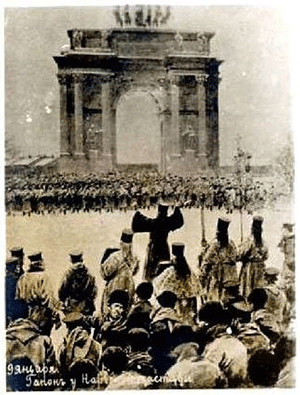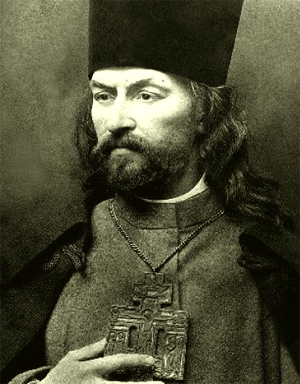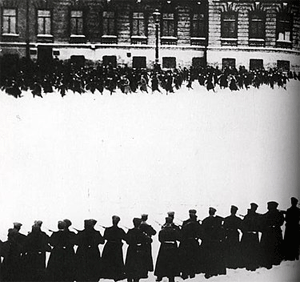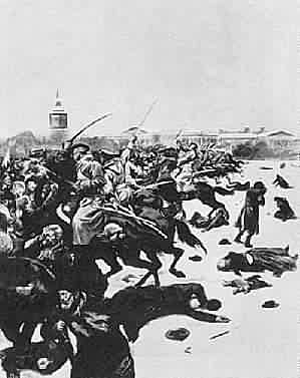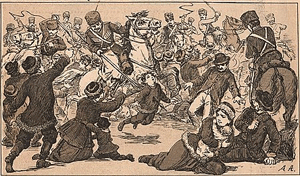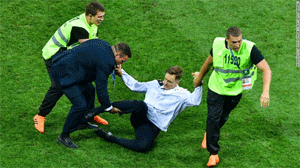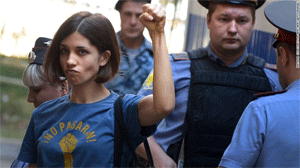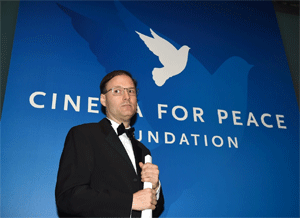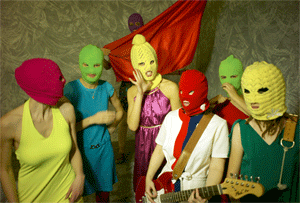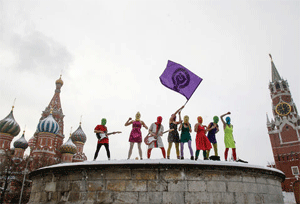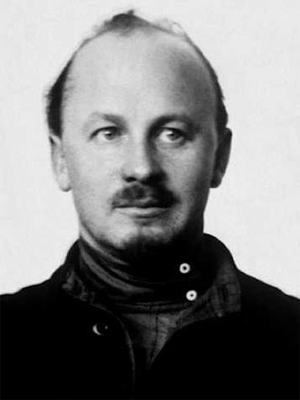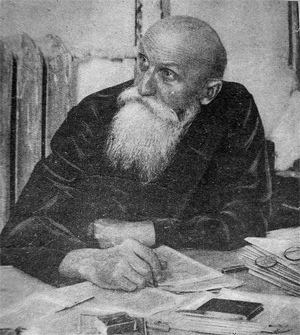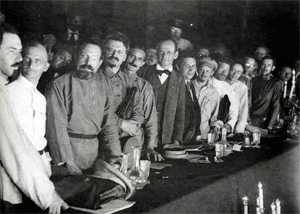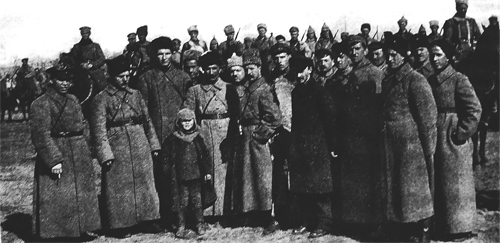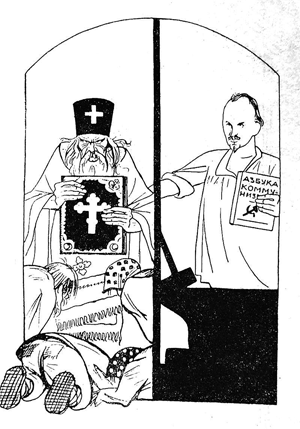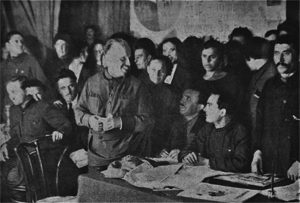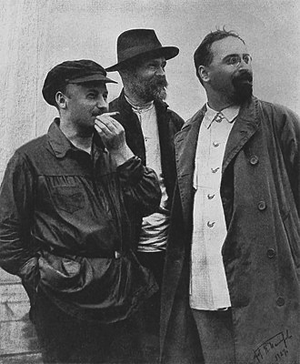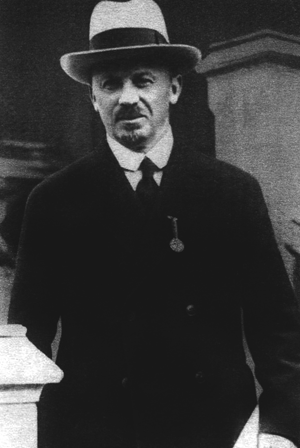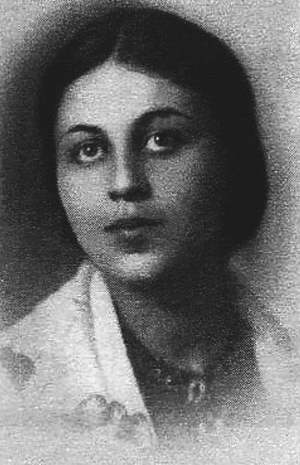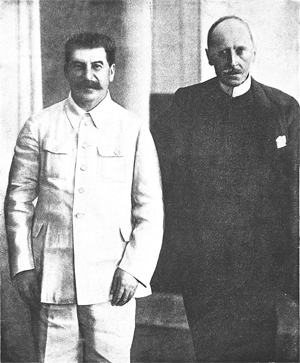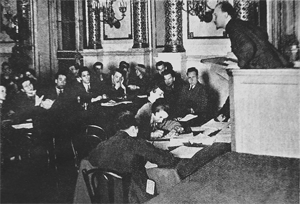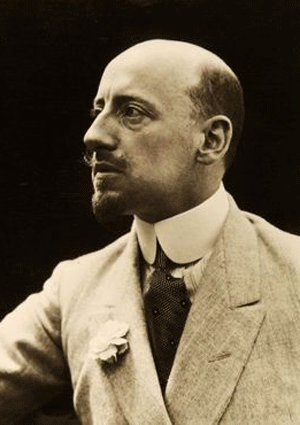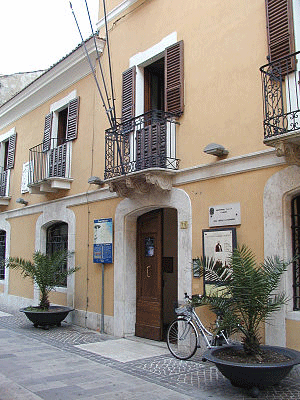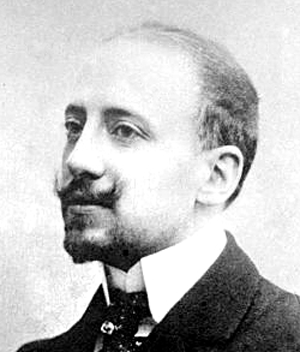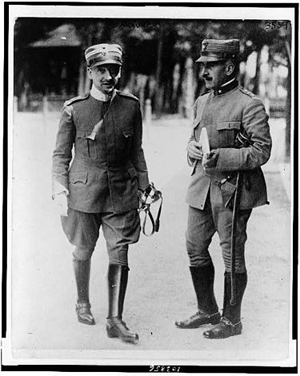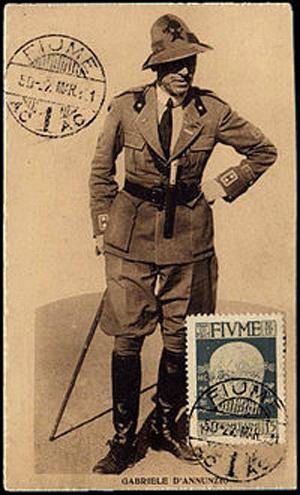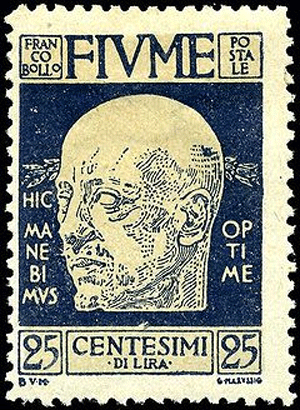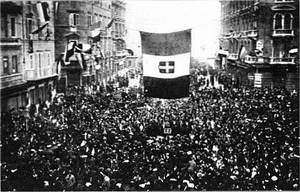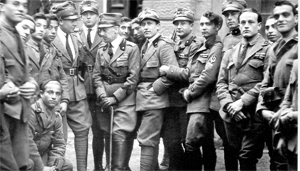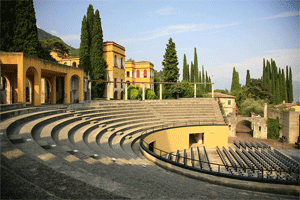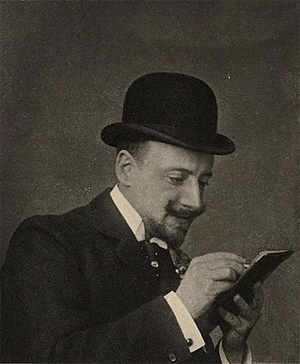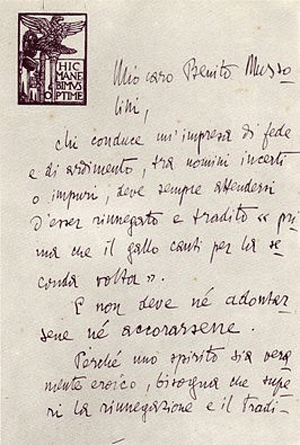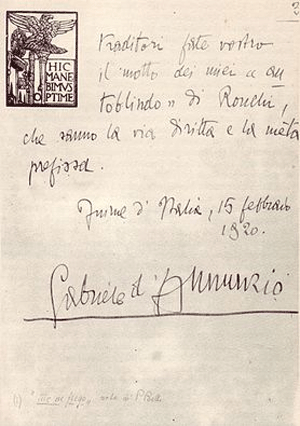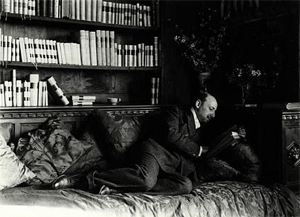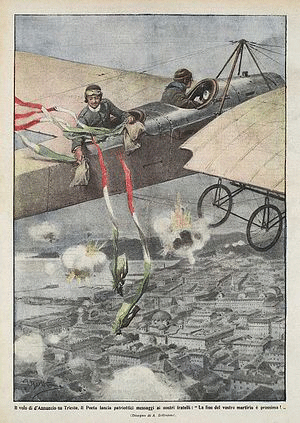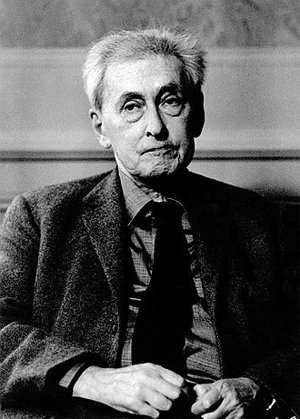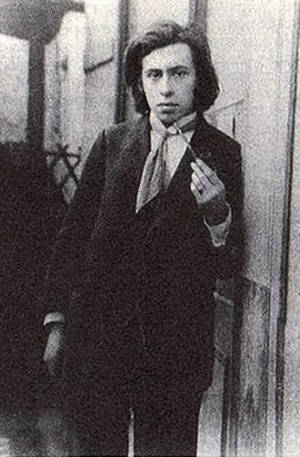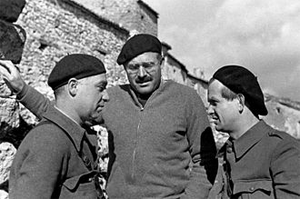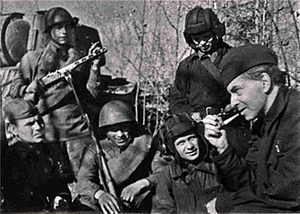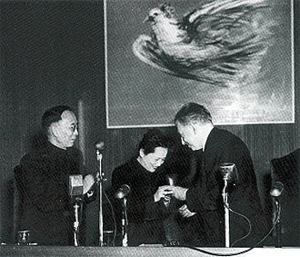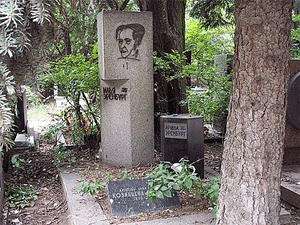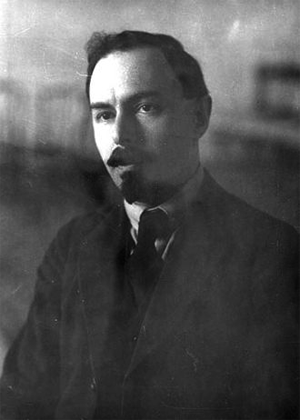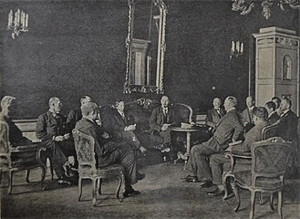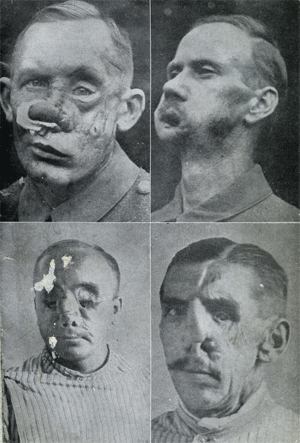October Revolution
The October Revolution was led by Vladimir Lenin and was based upon Lenin's writing on the ideas of Karl Marx, a political ideology often known as Marxism–Leninism. It marked the beginning of the spread of communism in the 20th century. It was far less sporadic than the revolution of February and came about as the result of deliberate planning and coordinated activity to that end.
Though Lenin was the leader of the Bolshevik Party, it has been argued that since Lenin was not present during the actual takeover of the Winter Palace, it was really Trotsky's organization and direction that led the revolution, merely spurred by the motivation Lenin instigated within his party.[30] Critics on the Right have long argued that the financial and logistical assistance of German intelligence via their key agent, Alexander Parvus was a key component as well, though historians are divided, since there is little evidence supporting that claim.
Chapter III: LENIN AND GERMAN ASSISTANCE FOR THE BOLSHEVIK REVOLUTIONIt was not until the Bolsheviks had received from us a steady flow of funds through various channels and under varying labels that they were in a position to be able to build up their main organ Pravda, to conduct energetic propaganda and appreciably to extend the originally narrow base of their party.
-- Von Kühlmann, minister of foreign affairs, to the kaiser, December 3, 1917
In April 1917 Lenin and a party of 32 Russian revolutionaries, mostly Bolsheviks, journeyed by train from Switzerland across Germany through Sweden to Petrograd, Russia. They were on their way to join Leon Trotsky to "complete the revolution." Their trans-Germany transit was approved, facilitated, and financed by the German General Staff. Lenin's transit to Russia was part of a plan approved by the German Supreme Command, apparently not immediately known to the kaiser, to aid in the disintegration of the Russian army and so eliminate Russia from World War I. The possibility that the Bolsheviks might be turned against Germany and Europe did not occur to the German General Staff. Major General Hoffman has written, "We neither knew nor foresaw the danger to humanity from the consequences of this journey of the Bolsheviks to Russia."1
At the highest level the German political officer who approved Lenin's journey to Russia was Chancellor Theobald von Bethmann-Hollweg, a descendant of the Frankfurt banking family Bethmann, which achieved great prosperity in the nineteenth century. Bethmann-Hollweg was appointed chancellor in 1909 and in November 1913 became the subject of the first vote of censure ever passed by the German Reichstag on a chancellor. It was Bethmann-Hollweg who in 1914 told the world that the German guarantee to Belgium was a mere "scrap of paper." Yet on other war matters — such as the use of unrestricted submarine warfare — Bethmann-Hollweg was ambivalent; in January 1917 he told the kaiser, "I can give Your Majesty neither my assent to the unrestricted submarine warfare nor my refusal." By 1917 Bethmann-Hollweg had lost the Reichstag's support and resigned — but not before approving transit of Bolshevik revolutionaries to Russia. The transit instructions from Bethmann-Hollweg went through the state secretary Arthur Zimmermann — who was immediately under Bethmann-Hollweg and who handled day-to-day operational details with the German ministers in both Bern and Copenhagen — to the German minister to Bern in early April 1917. The kaiser himself was not aware of the revolutionary movement until after Lenin had passed into Russia.
While Lenin himself did not know the precise source of the assistance, he certainly knew that the German government was providing some funding. There were, however, intermediate links between the German foreign ministry and Lenin, as the following shows:
From Berlin Zimmermann and Bethmann-Hollweg communicated with the German minister in Copenhagen, Brockdorff-Rantzau. In turn, Brockdorff-Rantzau was in touch with Alexander Israel Helphand (more commonly known by his alias, Parvus), who was located in Copenhagen.2 Parvus was the connection to Jacob Furstenberg, a Pole descended from a wealthy family but better known by his alias, Ganetsky. And Jacob Furstenberg was the immediate link to Lenin.
Although Chancellor Bethmann-Hollweg was the final authority for Lenin's transfer, and although Lenin was probably aware of the German origins of the assistance, Lenin cannot be termed a German agent. The German Foreign Ministry assessed Lenin's probable actions in Russia as being consistent with their own objectives in the dissolution of the existing power structure in Russia. Yet both parties also had hidden objectives: Germany wanted priority access to the postwar markets in Russia, and Lenin intended to establish a Marxist dictatorship.
The idea of using Russian revolutionaries in this way can be traced back to 1915. On August 14 of that year, Brockdorff-Rantzau wrote the German state undersecretary about a conversation with Helphand (Parvus), and made a strong recommendation to employ Helphand, "an extraordinarily important man whose unusual powers I feel we must employ for duration of the war .... "3 Included in the report was a warning: "It might perhaps be risky to want to use the powers ranged behind Helphand, but it would certainly be an admission of our own weakness if we were to refuse their services out of fear of not being able to direct them."4
Brockdorff-Rantzau's ideas of directing or controlling the revolutionaries parallel, as we shall see, those of the Wall Street financiers. It was J.P. Morgan and the American International Corporation that attempted to control both domestic and foreign revolutionaries in the United States for their own purposes.
A subsequent document5 outlined the terms demanded by Lenin, of which the most interesting was point number seven, which allowed "Russian troops to move into India"; this suggested that Lenin intended to continue the tsarist expansionist program. Zeman also records the role of Max Warburg in establishing a Russian publishing house and adverts to an agreement dated August 12, 1916, in which the German industrialist Stinnes agreed to contribute two million rubles for financing a publishing house in Russia.6
Consequently, on April 16, 1917, a trainload of thirty-two, including Lenin, his wife Nadezhda Krupskaya, Grigori Zinoviev, Sokolnikov, and Karl Radek, left the Central Station in Bern en route to Stockholm. When the party reached the Russian frontier only Fritz Plattan and Radek were denied entrance into Russia. The remainder of the party was allowed to enter. Several months later they were followed by almost 200 Mensheviks, including Martov and Axelrod.
It is worth noting that Trotsky, at that time in New York, also had funds traceable to German sources. Further, Von Kuhlmann alludes to Lenin's inability to broaden the base of his Bolshevik party until the Germans supplied funds. Trotsky was a Menshevik who turned Bolshevik only in 1917. This suggests that German funds were perhaps related to Trotsky's change of party label.
THE SISSON DOCUMENTS
In early 1918 Edgar Sisson, the Petrograd representative of the U.S. Committee on Public Information, bought a batch of Russian documents purporting to prove that Trotsky, Lenin, and the other Bolshevik revolutionaries were not only in the pay of, but also agents of, the German government.
These documents, later dubbed the "Sisson Documents," were shipped to the United States in great haste and secrecy. In Washington, D.C. they were submitted to the National Board for Historical Service for authentication. Two prominent historians, J. Franklin Jameson and Samuel N. Harper, testified to their genuineness. These historians divided the Sisson papers into three groups. Regarding Group I, they concluded:We have subjected them with great care to all the applicable tests to which historical students are accustomed and ... upon the basis of these investigations, we have no hesitation in declaring that we see no reason to doubt the genuineness or authenticity of these fifty-three documents.7
The historians were less confident about material in Group II. This group was not rejected as outright forgeries, but it was suggested that they were copies of original documents. Although the historians made "no confident declaration" on Group III, they were not prepared to reject the documents as outright forgeries.
The Sisson Documents were published by the Committee on Public Information, whose chairman was George Creel, a former contributor to the pro-Bolshevik Masses. The American press in general accepted the documents as authentic. The notable exception was the New York Evening Post, at that time owned by Thomas W. Lamont, a partner in the Morgan firm. When only a few installments had been published, the Post challenged the authenticity of all the documents.8
We now know that the Sisson Documents were almost all forgeries: only one or two of the minor German circulars were genuine. Even casual examination of the German letterhead suggests that the forgers were unusually careless forgers perhaps working for the gullible American market. The German text was strewn with terms verging on the ridiculous: for example, Bureau instead of the German word Büro; Central for the German Zentral; etc.
That the documents are forgeries is the conclusion of an exhaustive study by George Kennan9 and of studies made in the 1920s by the British government. Some documents were based on authentic information and, as Kennan observes, those who forged them certainly had access to some unusually good information. For example, Documents 1, 54, 61, and 67 mention that the Nya Banken in Stockholm served as the conduit for Bolshevik funds from Germany. This conduit has been confirmed in more reliable sources. Documents 54, 63, and 64 mention Furstenberg as the banker-intermediary between the Germans and the Bolshevists; Furstenberg's name appears elsewhere in authentic documents. Sisson's Document 54 mentions Olof Aschberg, and Olof Aschberg by his own statements was the "Bolshevik Banker." Aschberg in 1917 was the director of Nya Banken. Other documents in the Sisson series list names and institutions, such as the German Naptha-Industrial Bank, the Disconto Gesellschaft, and Max Warburg, the Hamburg banker, but hard supportive evidence is more elusive. In general, the Sisson Documents, while themselves outright forgeries, are nonetheless based partly on generally authentic information.
One puzzling aspect in the light of the story in this book is that the documents came to Edgar Sisson from Alexander Gumberg (alias Berg, real name Michael Gruzenberg), the Bolshevik agent in Scandinavia and later a confidential assistant to Chase National Bank and Floyd Odium of Atlas Corporation. The Bolshevists, on the other hand, stridently repudiated the Sisson material. So did John Reed, the American representative on the executive of the Third International and whose paycheck came from Metropolitan magazine, which was owned by J.P. Morgan interests.10 So did Thomas Lamont, the Morgan partner who owned the New York Evening Post. There are several possible explanations. Probably the connections between the Morgan interests in New York and such agents as John Reed and Alexander Gumberg were highly flexible. This could have been a Gumberg maneuver to discredit Sisson and Creel by planting forged documents; or perhaps Gumberg was working in his own interest.
The Sisson Documents "prove" exclusive German involvement with the Bolsheviks. They also have been used to "prove" a Jewish-Bolshevik conspiracy theory along the lines of that of the Protocols of Zion. In 1918 the U.S. government wanted to unite American opinion behind an unpopular war with Germany, and the Sisson Documents dramatically "proved" the exclusive complicity of Germany with the Bolshevists. The documents also provided a smoke screen against public knowledge of the events to be described in this book.
-- Wall Street and the Bolshevik Revolution, by Antony C. Sutton
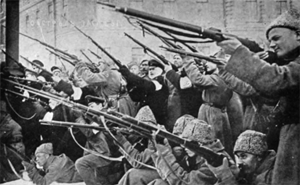
The dissolution of the Constituent Assembly on 6 January 1918. The Tauride Palace is locked and guarded by Trotsky, Sverdlov, Zinoviev and Lashevich.
On 7 November 1917, Bolshevik leader Vladimir Lenin led his leftist revolutionaries in a revolt against the ineffective Provisional Government (Russia was still using the Julian calendar at the time, so period references show a 25 October date). The October revolution ended the phase of the revolution instigated in February, replacing Russia's short-lived provisional parliamentary government with government by soviets, local councils elected by bodies of workers and peasants. Liberal and monarchist forces, loosely organized into the White Army, immediately went to war against the Bolsheviks' Red Army, in a series of battles that would become known as the Russian Civil War.
Soviet membership was initially freely elected, but many members of the Socialist Revolutionary Party, anarchists, and other leftists created opposition to the Bolsheviks through the soviets themselves. The elections to the Russian Constituent Assembly took place in November 1917. The Bolsheviks gained 24% of the vote.[31] When it became clear that the Bolsheviks had little support outside of the industrialized areas of Saint Petersburg and Moscow, they simply barred non-Bolsheviks from membership in the soviets.[citation needed] The Bolsheviks dissolved the Constituent Assembly in January 1918.[31] Not surprisingly, this caused mass domestic tension with many individuals who called for another series of political reform, revolting, and calling for "a third Russian revolution," a movement that received a significant amount of support. The most notable instances of this anti-Bolshevik mentality were expressed in the Tambov rebellion, 1919–1921, and the Kronstadt rebellion in March 1921. These movements, which made a wide range of demands and lacked effective coordination, were eventually defeated along with the White Army during the Civil War.
Russian Civil War
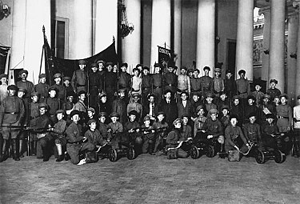
American, British, and Japanese Troops parade through Vladivostok in armed support to the White Army
The Russian Civil War, which broke out in 1918 shortly after the October Revolution, brought death and suffering to millions of people regardless of their political orientation. The war was fought mainly between the Red Army ("Reds"), consisting of the uprising majority led by the Bolshevik minority, and the "Whites" – army officers and cossacks, the "bourgeoisie", and political groups ranging from the far Right to the Socialist Revolutionaries who opposed the drastic restructuring championed by the Bolsheviks following the collapse of the Provisional Government to the soviets (under clear Bolshevik dominance).[32][33] The Whites had backing from nations such as Great Britain, France, USA and Japan, while the Reds possessed internal support which proved to be much more effective. Though the Allied nations, using external interference, provided substantial military aid to the loosely knit anti-Bolshevik forces, they were ultimately defeated.[32]
The Bolsheviks firstly assumed power in Petrograd, expanding their rule outwards. They eventually reached the Easterly Siberian Russian coast in Vladivostok, 4 years after the war began, an occupation that is believed to have ended all significant military campaigns in the nation. Less than one year later the last area controlled by the White Army, the Ayano-Maysky District, directly to the north of the Krai containing Vladivostok, was given up when General Anatoly Pepelyayev capitulated in 1923.
Several revolts were initiated against the Bolsheviks and their army near the end of the war, notably the Kronstadt Rebellion. This was a naval mutiny engineered by Soviet Baltic sailors, former Red Army soldiers, and the people of Kronstadt. This armed uprising was fought against the antagonizing Bolshevik economic policies that farmers were subjected to, including seizures of grain crops by the Communists.[34] This all amounted to large-scale discontent. When delegates representing the Kronstadt sailors arrived at Petrograd for negotiations, they raised 15 demands primarily pertaining to the Russian right to freedom.[35] The Government firmly denounced the rebellions and labelled the requests as a reminder of the Social Revolutionaries, a political party that was popular among Soviets before Lenin, but refused to cooperate with the Bolshevik Army. The Government then responded with an armed suppression of these revolts and suffered 10 thousand casualties before entering the city of Kronstadt.[36] This ended the rebellions fairly quickly, causing many of the rebels to flee to political exile.[37]
During the Civil War, Nestor Makhno led a Ukrainian anarchist movement, the Black Army allied to the Bolsheviks thrice, one of the powers ending the alliance each time. However, a Bolshevik force under Mikhail Frunze destroyed the Makhnovist movement, when the Makhnovists refused to merge into the Red Army. In addition, the so-called "Green Army" (peasants defending their property against the opposing forces) played a secondary role in the war, mainly in the Ukraine.
Execution of the imperial family
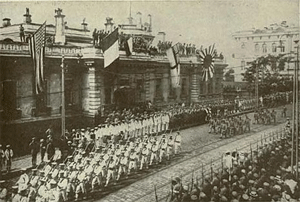
Execution of the Romanov family, Le Petit Journal
The Bolsheviks executed the tsar and his family on 16 July 1918.[38] In early March, the Provisional Government placed Nicholas and his family under house arrest in the Alexander Palace at Tsarskoye Selo, 24 kilometres (15 mi) south of Petrograd. In August 1917 the Kerensky government evacuated the Romanovs to Tobolsk in the Urals, to protect them from the rising tide of revolution. After the Bolsheviks came to power in October 1917, the conditions of their imprisonment grew stricter and talk of putting Nicholas on trial increased. As the counter revolutionary White movement gathered force, leading to full-scale civil war by the summer, the Romanovs were moved during April and May 1918 to Yekaterinburg, a militant Bolshevik stronghold.
During the early morning of 16 July, Nicholas, Alexandra, their children, their physician, and several servants were taken into the basement and shot. According to Edvard Radzinsky and Dmitrii Volkogonov, the order came directly from Lenin and Sverdlov in Moscow. That the order came from the top has long been believed, although there is a lack of hard evidence. The execution may have been carried out on the initiative of local Bolshevik officials, or it may have been an option pre-approved in Moscow should White troops approach Yekaterinburg. Radzinsky noted that Lenin's bodyguard personally delivered the telegram ordering the execution and that he was ordered to destroy the evidence.[39][40]
The revolution and the world
Leon Trotsky said that the goal of socialism in Russia would not be realized without the success of the world revolution. Indeed, a revolutionary wave caused by the Russian Revolution lasted until 1923. Despite initial hopes for success in the German Revolution of 1918–19, in the short-lived Hungarian Soviet Republic and others like it, no other Marxist movement at the time succeeded in keeping power in its hands.
This issue is subject to conflicting views on communist history by various Marxist groups and parties. Joseph Stalin later rejected this idea, stating that socialism was possible in one country.
The confusion regarding Stalin's position on the issue stems from the fact that, after Lenin's death in 1924, he successfully used Lenin's argument – the argument that socialism's success needs the support of workers of other countries in order to happen – to defeat his competitors within the party by accusing them of betraying Lenin and, therefore, the ideals of the October Revolution.
Historiography
Few events in historical research have been as conditioned by political influences as the October Revolution. The historiography of the Revolution generally divides into three camps: the Soviet-Marxist view, the Western-Totalitarian view, and the Revisionist view.[41] Since the fall of Communism in Russia in 1991, the Western-Totalitarian view has again become dominant and the Soviet-Marxist view has practically vanished.[42]
Lenin's biographer Robert Service, says he, "laid the foundations of dictatorship and lawlessness. Lenin had consolidated the principle of state penetration of the whole society, its economy and its culture. Lenin had practised terror and advocated revolutionary amoralism."[43]
Chronology
Chronology of events leading to the revolution
Dates are correct for the Julian calendar, which was used in Russia until 1918. It was twelve days behind the Gregorian calendar during the 19th century and thirteen days behind it during the 20th century.
Date(s) / Event(s)
1874–81 / Growing anti-government terrorist movement and government reaction.
1881 / Alexander II assassinated by revolutionaries; succeeded by Alexander III.
1883 / First Russian Marxist group formed.
1894 / Start of reign of Nicholas II.
1898 / First Congress of Russian Social Democratic Labour Party (RSDLP).
1900 / Foundation of Socialist Revolutionary Party (SR).
1903 / Second Congress of Russian Social Democratic Labour Party. Beginning of split between Bolsheviks and Mensheviks.
1904–5 / Russo-Japanese War; Russia loses war.
1905 / Revolution of 1905.
1905 / January Bloody Sunday in Saint Petersburg.
1905 / June Battleship Potemkin uprising at Odessa on the Black Sea (see movie The Battleship Potemkin).
1905 / October General strike, Saint Petersburg Soviet formed; October Manifesto: Imperial agreement on elections to the State Duma.
1906 / First State Duma. Prime Minister: Petr Stolypin. Agrarian reforms begin.
1907 / Third State Duma, until 1912.
1911 / Stolypin assassinated.
1912 / Fourth State Duma, until 1917. Bolshevik/Menshevik split final.
1914 / Germany declares war on Russia.
1914 30 July / The All Russian Zemstvo Union for the Relief of Sick and Wounded Soldiers is created with Lvov as president.
1914 August–November / Russia suffers heavy defeats and a large shortage of supplies, including food and munitions, but holds onto Austrian Galicia.
1914 3 August / Germany declares war on Russia, causing a brief sense of patriotic union amongst the Russian nation and a downturn in striking.
1914 18 August / St. Petersburg is renamed Petrograd as 'Germanic' names are changed to sound more Russian, and hence more patriotic.
1914 5 November / Bolshevik members of the Duma are arrested; they are later tried and exiled to Siberia.
1915 / Serious defeats, Nicholas II declares himself Commander in Chief.
1915 19 February / Great Britain and France promise Russia Istanbul and other Turkish lands.
1915 5 June / Strikers shot at in Kostromá; casualties.
1915 9 July / The Great Retreat begins, as Russian forces pull back out of Galicia and Russian Poland into Russia proper.
1915 9 August / The Duma's bourgeois parties form the 'Progressive bloc' to push for better government and reform; includes the Kadets, Octobrist groups and Nationalists.
1915 10 August / Strikers shot at in Ivánovo-Voznesénsk; casualties.
1915 17–19 August / Strikers in Petrograd protest at the deaths in Ivánovo-Voznesénsk.
1915 23 August / Reacting to war failures and a hostile Duma, the Tsar takes over as Commander-in-Chief of the armed forces, prorogues the Duma and moves to military headquarters at Mogilev. Central government begins to seize up.
1916 / Food and fuel shortages and high prices. Progressive Bloc formed.
1916 January–December / Despite successes in the Brusilov offensive, the Russian war effort is still characterised by shortages, poor command, death and desertion. Away from the front, the conflict causes starvation, inflation and a torrent of refugees. Both soldiers and civilians blame the incompetence of the Tsar and his government.
1916 6 February / Duma reconvened.
1916 29 February / After a month of strikes at the Putílov Factory, the government conscripts the workers and takes charge of production. Protest strikes follow.
1916 20 June / Duma prorogued.
1916 October / Troops from 181st Regiment help striking Russkii Renault workers fight against the Police.
1916 1 November / Miliukov gives his 'Is this stupidity or treason?' speech in reconvened Duma.
1916 29 December / Rasputin is killed by Prince Yusupov.
1916 30 December / The Tsar is warned that his army will not support him against a revolution.
1917 S/ trikes, mutinies, street demonstrations lead to the fall of autocracy.
Chronology of the 1917 revolutions
Gregorian Date / Julian Date / Event
-- / January / Strikes and unrest in Petrograd.
-- / February / February Revolution.
8 March / 23 February / International Women's Day: strikes and demonstrations in Petrograd, growing over the next few days.
11 March / 26 February / 50 demonstrators killed in Znamenskaya Square Tsar Nicholas II prorogues the State Duma and orders commander of Petrograd military district to suppress disorders with force.
12 March / 27 February / * Troops refuse to fire on demonstrators, deserters. Prisons, courts, and police bumbs attacked and looted by angry crowds. Okhrana buildings set on fire. Garrison joins revolutionaries. Petrograd Soviet formed. Formation of Provisional Committee of the Duma by liberals from Constitutional Democratic Party (Kadets).
14 March / 1 March / Order No.1 of the Petrograd Soviet.
15 March / 2 March / Nicholas II abdicates. Provisional Government formed under Prime Minister Prince Lvov.
16 April / 3 April / Return of Vladimir Lenin to Russia. He publishes his April Theses.
3–4 May / 20–21 April / "April Days": mass demonstrations by workers, soldiers, and others in the streets of Petrograd and Moscow triggered by the publication of the Foreign Minister Pavel Miliukov's note to the allies, which was interpreted as affirming commitment to the war policies of the old government. First Provisional Government falls.
18 May / 5 May / First Coalition Government forms when socialists, representatives of the Soviet leadership, agree to enter the cabinet of the Provisional Government. Alexander Kerensky, the only socialist already in the government, made minister of war and navy.
16 June / 3 June / First All-Russian Congress of Workers' and Soldiers' Deputies opens in Petrograd. Closed on 24 June. Elects Central Executive Committee of Soviets (VTsIK), headed by Mensheviks and SRs.
23 June / 10 June / Planned Bolshevik demonstration in Petrograd banned by the Soviet.
29 June / 16 June / Kerensky orders offensive against Austro-Hungarian forces. Initial success only.
1 July / 18 June / Official Soviet demonstration in Petrograd for unity is unexpectedly dominated by Bolshevik slogans: "Down with the Ten Capitalist Ministers", "All Power to the Soviets".
15 July / 2 July / Russian offensive ends. Trotsky joins Bolsheviks.
16–17 July / 3–4 July / The "July Days"; mass armed demonstrations in Petrograd, encouraged by the Bolsheviks, demanding "All Power to the Soviets".
19 July / 6 July / German and Austro-Hungarian counter-attack. Russians retreat in panic, sacking the town of Tarnopol. Arrest of Bolshevik leaders ordered.
20 July / 7 July / Lvov resigns and asks Kerensky to become Prime Minister and form a new government. Established 25 July.
4 August / 22 July / Trotsky and Lunacharskii arrested.
8 September / 26 August / Second coalition government ends.
8–12 September / 26–30 August / "Kornilov mutiny". Begins when the commander-in-chief of the Russian army, General Lavr Kornilov, demands (or is believed by Kerensky to demand) that the government give him all civil and military authority and moves troops against Petrograd.
13 September / 31 August / Majority of deputies of the Petrograd Soviet approve a Bolshevik resolution for an all-socialist government excluding the bourgeoisie.
14 September / 1 September / Russia declared a republic.
17 September / 4 September / Trotsky and others freed.
18 September / 5 September / Bolshevik resolution on the government wins majority vote in Moscow Soviet.
2 October / 19 September / Moscow Soviet elects executive committee and new presidium, with Bolshevik majorities, and the Bolshevik Viktor Nogin as chairman.
8 October / 25 September / Third coalition government formed. Bolshevik majority in Petrograd Soviet elects Bolshevik Presidium and Trotsky as chairman.
23 October / 10 October / Bolshevik Central Committee meeting approves armed uprising.
24 October / 11 October / Congress of Soviets of the Northern Region, until 13 October.
2 November / 20 October / First meeting of the Military Revolutionary Committee of the Petrograd Soviet.
7 November / 25 October / October Revolution is launched as MRC directs armed workers and soldiers to capture key buildings in Petrograd. Winter Palace attacked at 9:40pm and captured at 2am. Kerensky flees Petrograd. Opening of the 2nd All-Russian Congress of Soviets.
8 November / 26 October / Second Congress of Soviets: Mensheviks and right SR delegates walk out in protest against the previous day's events. Congress approves transfer of state authority into its own hands and local power into the hands of local soviets of workers', soldiers', and peasants' deputies, abolishes capital punishment, issues Decree on Peace and Decree on Land, and approves the formation of an all-Bolshevik government, the Council of People's Commissars (Sovnarkom), with Lenin as chairman.
Cultural portrayal
George Orwell's classic novella Animal Farm is an allegory of the Russian Revolution and its aftermath. It describes the dictator Stalin as a big Berkshire boar named, "Napoleon." Trotsky is represented by a pig called Snowball who is a brilliant talker and makes magnificent speeches. However, Napoleon overthrows Snowball as Stalin overthrew Trotsky and Napoleon takes over the farm the animals live on. Napoleon becomes a tyrant and uses force and propaganda to oppress the animals.[44]
Film
The Russian Revolution has been portrayed in or served as backdrop for many films. Among them, in order of release date:
• The White Guard, Mikhail Bulgakov, 1926. Partially autobiographical novel, portraying the life of one family torn apart by uncertainty of the Civil War times. Also, Dni Turbinykh (IMDB profile), 1976 – film based on the novel.
• Konets Sankt-Peterburga AKA The End of Saint Petersburg (IMDB profile). 1927. Directed by Vsevolod Pudovkin and Mikhail Doller, USSR.
• October: Ten Days That Shook the World (IMDB profile). 1927. Directed by Sergei Eisenstein and Grigori Aleksandrov. Soviet Union. Black and White. Silent.
• Arsenal (IMDB profile). 1929. Set in the Ukraine. Written and directed by Aleksandr Dovzhenko.
• Scarlet Dawn, a 1932 Pre-Code American romantic drama starring Douglas Fairbanks, Jr. and Nancy Carroll caught up in the fallout of the Russian Revolution.
• Knight Without Armour. 1937. A British historical drama starring Marlene Dietrich and Robert Donat, with Dietrich as an imperiled aristocrat on the eve of the Russian Revolution.
• Lenin v 1918 godu AKA Lenin in 1918 (IMDB profile). 1939. Directed by Mikhail Romm, E. Aron, and I. Simkov. Historical-revolutionary film about Lenin's activities in the first years of Soviet power.
• Doctor Zhivago. 1965. A drama-romance-war film directed by David Lean, filmed in Europe with a largely European cast, loosely based on the famous novel of the same name by Boris Pasternak.
• Reds (IMDB profile). 1981. Directed by Warren Beatty, it is based on the book Ten Days that Shook the World.
• Anastasia (IMDB profile). 1997. An American animated feature, directed by Don Bluth and Gary Goldman.
See also
• April Crisis
• Arthur Ransome
• Jacob Schiff
• John Reed (journalist)
• White Terror (Russia)
• Iranian Revolution
Footnotes
1. Scholarly literature on peasants is now extensive. Major recent works that examine themes discussed above (and can serve as a guide to older scholarship) Christine Worobec, Peasant Russia: Family and Community in the Post Emancipation Period (Princeton, 1955); Frank and Steinberg, eds., Cultures in Flux(Princeton, 1994); Barbara Alpern Engel, Between the Fields and the City: Women, Work, and Family in Russia, 1861–1914 (Cambridge, 1994); Jeffrey Burds, Peasant Dreams and Market Politics (Pittsburgh, 1998); Stephen Frank, Crime, Cultural Conflict and Justice in Rural Russia, 1856–1914 (Berkeley, 1999).
2. Among the many scholarly works on Russian workers, see especially Reginald Zelnik (pl), Labor and Society in Tsarist Russia: The Factory Workers of St. Petersburg, 1855–1870 (Stanford, 1971); Victoria Bonnell, Roots of Rebellion: Workers' Politics and Organizations in St. Petersburg and Moscow, 1900–1914(Berkeley, 1983).
3. See, especially, Dominic Lieven, Nicholas II: Emperor of all the Russias (London, 1993); Andrew Verner, The Crisis of the Russian Autocracy: Nicholas II and the 1905 Revolution (Princeton, 1990); Mark Steinberg and Vladimir Khrustalev, The Fall of the Romanovs: Political Dreams and Personal Struggles in a Time of Revolution (New Haven, 1995); Richard Wortman, Scenarios of Power, vol. 2 (Princeton, 2000); Orlando Figes, A People's Tragedy: The Russian Revolution 1891–1924, Part One.
Notes
1. Orlando Figes, A Peoples Tragedy, p370
2. Wood, 1979. p. 18
3. Perfect; Ryan; Sweeny (2016). Reinventing Russia. Collingwood: History Teachers Association of Victoria. ISBN 9781875585052.
4. Wood, 1979. p. 24
5. Wood, 1979. p. 25
6. Wood, 1979. p. 26
7. Joel Carmichael, A short history of the Russian Revolution, pp 23–24
8. Abraham Ascher, The Revolution of 1905: A Short History, page 6
9. Allan Wildman, The End of the Russian Imperial Army, vol. 1 (Princeton, 1980): 76–80
10. Hubertus Jahn, Patriotic Culture in Russia During World War I (Ithaca, 1995)
11. Figes, A People's Tragedy, 257–258.
12. Wildman: The End of the Russian Imperial Army (I), p. 85–89, 99–105, 106 (quotation).
13. "Doklad petrogradskogo okhrannogo otdeleniia osobomu otdelu departamenta politsii" ["Report of the Petrograd Okhrana to the Special Department of the Department of the Police"], October 1916, Krasnyi arkhiv 17 (1926), 4–35 (quotation 4).
14. Service, 2005. p. 32.
15. When women set Russia ablaze, Fifth International 11 July 2007.
16. Beckett, 2007. p. 523.
17. Wade, 2005. pp. 40–43.
18. Browder and Kerensky, 1961. p. 116.
19. Tames, 1972.
20. Malone, 2004. p. 91.
21. Service, 2005. p. 34.
22. N. N. Sukhanov, The Russian Revolution: A Personal Record, ed. and trans. Joel Carmichael (Oxford, 1955; originally published in Russian in 1922), 101–8.
23. "Zhurnal [No. 1] Soveta Ministrov Vremennogo Pravitel'stva," 2 March 1917, GARF (State Archive of the Russian Federation), f. 601, op. 1, d. 2103, l. 1
24. Smele, Jonathan (2017). The "Russian" Civil Wars, 1916-1926. Oxford: Oxford University Press. p. 27.
25. Lenin, Vladimir (27 September 1964) [1917]. Apresyan, Stephen, ed. One of the Fundamental Questions of the Revolution (in Russian). 25. Jim Riordan (4th ed.). Moscow: Progress Publishers. pp. 370–77.
26. Stephen Cohen, Bukharin and the Bolshevik Revolution: A Political Biography 1888–1938 (Oxford University Press: London, 1980) p. 46.
27. Stephen Cohen, Bukharin and the Bolshevik Revolution: A Political Biography 1888–1938, p. 46.
28. V. I. Lenin, "State and Revolution" contained in the Collected Works of Lenin: Volume 25 (Progress Publishers: Moscow, 1974) pp. 3395–487.
29. V. I. Lenin, "The Bolsheviks Must Assume Power" contained in the Collected Works of Lenin: Volume 26(Progress Publishers: Moscow, 1972) p. 21.
30. Isaac Deutscher The Prophet Armed
31. Caplan, Bryan. "Lenin and the First Communist Revolutions, IV". George Mason University.
32. Riasanovsky, Nichlas V.; Steinberg, Mark D. (2005). A History of Russia (7th ed.). Oxford University Press. ISBN 0195153944.
33. article "Civil War and military intervention in Russia 1918–20", Big Soviet Encyclopedia, third edition (30 volumes), 1969–78
34. "The Kronstadt Mutiny notes on Orlando Figes, A People's Tragedy (1996)"
35. Petrograd on the Eve of Kronstadt rising 1921 Archived 15 July 2012 at Archive.is. Flag.blackened.net (10 March 1921). Retrieved on 2013-07-26.
36. Orlando Figes, A People's Tragedy: The Russian Revolution 1891–1924 (New York: Viking Press 1997), 767.
37. Kronstadtin kapina 1921 ja sen perilliset Suomessa (Kronstadt Rebellion 1921 and Its Descendants in Finland) by Erkki Wessmann.
38. Robert K. Massie (2012). The Romanovs: The Final Chapter. Random House. pp. 3–24.
39. Dmitrii Volkogonov, Lenin: A New Biography (New York: Free Press, 1994).
40. Edvard Radzinsky, The Last Tsar: The Life And Death Of Nicholas II (New York: Knopf, 1993).
41. Acton, Critical Companion, 5-7.
42. Edward Acton, ed. Critical Companion to the Russian Revolution, 1914–1921 (Indiana University Press, 1997), pp 3-17.
43. Robert Service, "Lenin" in Edward Acton; et al. (1997). Critical Companion to the Russian Revolution, 1914-1921. Indiana University Press. p. 159.
44. Robert W. Menchhofer (1990). Animal Farm. Lorenz Educational Press. pp. 1–8.
Further reading
• Acton, Edward, Vladimir Cherniaev, and William G. Rosenberg, eds. A Critical Companion to the Russian Revolution, 1914–1921 (Bloomington, 1997).
• Ascher, Abraham. The Russian Revolution: A Beginner's Guide (Oneworld Publications, 2014)
• Beckett, Ian F.W. (2007). The Great war (2 ed.). Longman. ISBN 1-4058-1252-4.
• Brenton, Tony. Was Revolution Inevitable?: Turning Points of the Russian Revolution (Oxford UP, 2017).
• Cambridge History of Russia, vol. 2–3, England: Cambridge University Press. ISBN 0-521-81529-0(vol. 2) ISBN 0-521-81144-9 (vol. 3).
• Chamberlin, William Henry. The Russian Revolution, Volume I: 1917-1918: From the Overthrow of the Tsar to the Assumption of Power by the Bolsheviks; The Russian Revolution, Volume II: 1918-1921: From the Civil War to the Consolidation of Power (1935), famous classic
• Figes, Orlando (1996). A People's Tragedy: The Russian Revolution: 1891-1924. Pimlico.
• Daly, Jonathan, and Leonid Trofimov, eds. "Russia in War and Revolution, 1914-1922: A Documentary History." (Indianapolis and Cambridge, MA: Hackett Publishing Company, 2009). ISBN 978-0-87220-987-9.
• Fitzpatrick, Sheila. The Russian Revolution. 199 pages. Oxford University Press; (2nd ed. 2001). ISBN 0-19-280204-6.
• Lincoln, W. Bruce. Passage Through Armageddon: The Russians in War and Revolution, 1914–1918. (New York, 1986).
• Malone, Richard (2004). Analysing the Russian Revolution. Cambridge University Press. p. 67. ISBN 0-521-54141-7.
• Marples, David R. Lenin's Revolution: Russia, 1917-1921 (Routledge, 2014).
• Mawdsley, Evan. Russian Civil War(2007). 400p.
• Piper, Jessica. Events That Changed the Course of History: The Story of the Russian Revolution 100 Years Later (Atlantic Publishing Company, 2017), popular history.
• Rappaport, Helen. Caught in the Revolution: Petrograd, Russia, 1917–A World on the Edge(Macmillan, 2017).
• Pipes, Richard. The Russian Revolution (New York, 1990)
• Pipes, Richard (1997). Three "whys" of the Russian Revolution. Vintage Books. ISBN 978-0-679-77646-8.
• Service, Robert. Lenin: A Biography (2000); one vol edition of his three volume scholarly biography
• Robert Service (2005). A history of modern Russia from Nicholas II to Vladimir Putin. Harvard University Press. ISBN 978-0-674-01801-3.
• Service, Robert (1993). The Russian Revolution, 1900-1927. Basingstoke: MacMillan. ISBN 0333560361.
• Shukman, Harold, ed. The Blackwell Encyclopedia of the Russian Revolution (1998) articles by over 40 specialists
• Smele, Jonathan. The 'Russian' Civil Wars, 1916-1926: Ten Years That Shook the World (Oxford UP, 2016).
• Stoff, Laurie S. They Fought for the Motherland: Russia's Women Soldiers in World War I & the Revolution (2006) 294pp
• Swain, Geoffrey. Trotsky and the Russian Revolution (Routledge, 2014)
• Tames, Richard (1972). Last of the Tsars. London: Pan Books Ltd. ISBN 978-0-330-02902-5.
• Wade, Rex A. (2005). The Russian Revolution, 1917. Cambridge University Press. ISBN 978-0-521-84155-9.
• Wade, R. (2000). The Russian Revolution, 1917. Cambridge: University Press.
• Walston, Oliver (2005). Russian revolution. 76: Farmers Weekly.
• White, James D. Lenin: The Practice & Theory of Revolution (2001) 262pp
• Wood, Alan (1993). The origins of the Russian Revolution, 1861-1917. London: Routledge. ISBN 0415102324.
Historiography
• Gatrell, Peter. "Tsarist Russia at War: The View from Above, 1914–February 1917" Journal of Modern History 87#4 (2015) 668-700 online
• Haynes, Mike and Wolfreys, Jim (eds). History and Revolution: Refuting Revisionism. Verso Books, 2007. ISBN 978-1844671502
• Smith, S. A. "The historiography of the Russian revolution 100 years on." Kritika: Explorations in Russian and Eurasian History 16.4 (2015): 733-749.
• Smith, Steve. "Writing the History of the Russian Revolution after the Fall of Communism." Europe‐Asia Studies 46.4 (1994): 563-578.
• Wade, Rex A. "The Revolution at One Hundred: Issues and Trends in the English Language Historiography of the Russian Revolution of 1917." Journal of Modern Russian History and Historiography 9.1 (2016): 9-38.
• Warth, Robert D. "On the Historiography of the Russian Revolution." Slavic Review 26.2 (1967): 247-264.
Participants' accounts
• Reed, John. Ten Days that Shook the World. 1919, 1st Edition, published by BONI & Liveright, Inc. for International Publishers. Transcribed and marked by David Walters for John Reed Internet Archive. Penguin Books; 1st edition. 1 June 1980. ISBN 0-14-018293-4. Retrieved 14 May 2005.
• Serge, Victor. Year One of the Russian Revolution. L'An l de la revolution russe, 1930. Year One of the Russian Revolution, Holt, Rinehart, and Winston. Translation, editor's Introduction, and notes © 1972 by Peter Sedgwick. Reprinted on Victor Serge Internet Archive by permission. ISBN 0-86316-150-2. Retrieved 14 May 2005.
• Steinberg, Mark, Voices of Revolution, 1917. Yale University Press, 2001
• Trotsky, Leon. The History of the Russian Revolution. Translated by Max Eastman, 1932. Library of Congress Catalog Card Number 8083994. ISBN 0-913460-83-4. Transcribed for the World Wide Web by John Gowland (Australia), Alphanos Pangas (Greece) and David Walters (United States). Pathfinder Press edition. 1 June 1980. ISBN 0-87348-829-6. Retrieved 14 May 2005.
Primary documents
• Ascher, Abraham, ed. The Mensheviks in the Russian Revolution (Ithaca, 1976).
• Browder, Robert Paul and Alexander F. Kerensky, eds., The Russian Provisional Government, 1917: Documents. 3 volumes (Stanford, 1961).
• Bunyan, James and H. H. Fisher, eds. The Bolshevik Revolution, 1917–1918: Documents and Materials (Stanford, 1961; first ed. 1934).
• Daly, Jonathan, and Leonid Trofimov, eds. "Russia in War and Revolution, 1914-1922: A Documentary History." (Indianapolis and Cambridge, MA: Hackett Publishing Company, 2009). ISBN 978-0-87220-987-9.
• Miller, Martin A., ed. Russian Revolution: The Essential Readings (2001) 304pp
• Steinberg, Mark D. Voices of Revolution, 1917. In the series "Annals of Communism," Yale University Press, 2001. 404pp On-line publication of these texts in the Russian original: Golosa revoliutsii, 1917 g. (Yale University Press, 2002)
• Zeman, Z. A. B. ed. Germany and the Revolution in Russia, 1915-1918: Documents from the Archives of the German Foreign Ministry (1958) in Questia
External links
• Read, Christopher: Revolutions (Russian Empire) , in: 1914-1918-online. International Encyclopedia of the First World War.
• Brudek, Paweł: Revolutions (East Central Europe) , in: 1914-1918-online. International Encyclopedia of the First World War.
• Sumpf, Alexandre: Russian Civil War , in: 1914-1918-online. International Encyclopedia of the First World War.
• Mawdsley, Evan: International Responses to the Russian Civil War (Russian Empire) , in: 1914-1918-online. International Encyclopedia of the First World War.
• Melancon, Michael S.: Social Conflict and Control, Protest and Repression (Russian Empire) , in: 1914-1918-online. International Encyclopedia of the First World War.
• Sanborn, Joshua A.: Russian Empire , in: 1914-1918-online. International Encyclopedia of the First World War.
• Gaida, Fedor Aleksandrovich: Governments, Parliaments and Parties (Russian Empire) , in: 1914-1918-online. International Encyclopedia of the First World War.
• Albert, Gleb: Labour Movements, Trade Unions and Strikes (Russian Empire) , in: 1914-1918-online. International Encyclopedia of the First World War.
• Gatrell, Peter: Organization of War Economies (Russian Empire) , in: 1914-1918-online. International Encyclopedia of the First World War.
• Marks, Steven G.: War Finance (Russian Empire) , in: 1914-1918-online. International Encyclopedia of the First World War.
• Orlando Figes's free educational website on the Russian Revolution and Soviet history, May 2014
• Avrahm Yarmolinsky, Road to Revolution: A Century of Russian Radicalism, 1956.
• Soviet history archive at http://www.marxists.org
• Précis of Russian Revolution A summary of the key events and factors of the 1917 Russian Revolution.
• Kevin Murphy's Isaac and Tamara Deutscher Memorial Prize lecture Can we Write the History of the Russian Revolution, which examines historical accounts of 1917 in the light of newly accessible archive material.
• Thanks to Trotsky, the 'insurrection' was bloodless
• Violence and Revolution in 1917. Mike Haynes for Jacobin. 17 July 2017.


